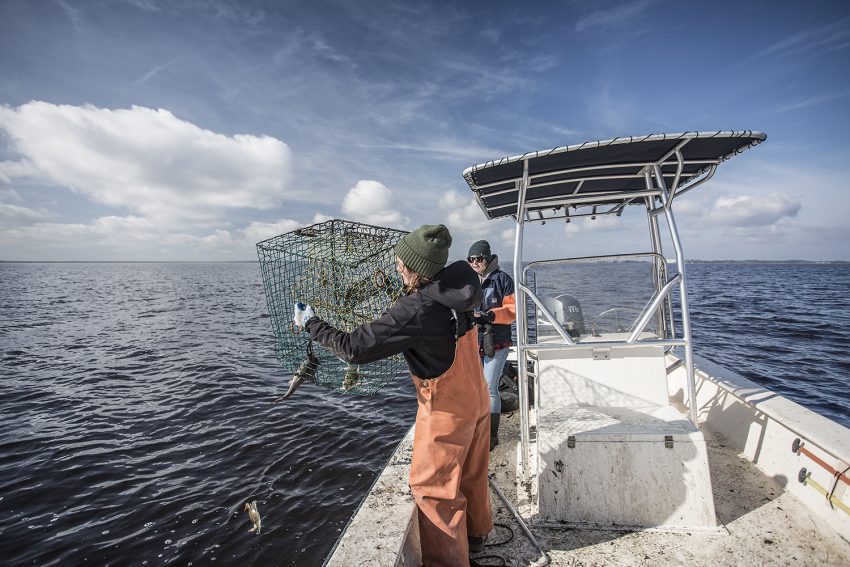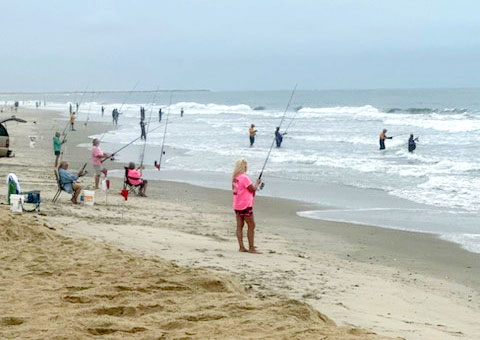2012 commercial and recreational fish and shellfish harvests are released
North Carolina commercial and recreational seafood harvests dropped in 2012, likely due to a combination of environmental, economic, and regulatory factors, including the shoaling of Oregon Inlet.
Commercial fishermen harvested 56.7 million pounds of finfish and shellfish from North Carolina coastal waters in 2012, a 16 percent drop from the previous year, according to the North Carolina Trip Ticket Program. However, the value of commercial landings increased by 2.6 percent in 2012 to $73 million.
Recreational anglers harvested an estimated 12 million pounds of finfish (8.1 million fish) in 2012, a 9 percent decrease from 2011, according to the state’s Coastal Angling Program. However, anglers released an estimated 18.5 million fish, 16.8 percent more than in 2011.
Commercial Harvests
Blue crabs remained at the top the state’s commercial harvest, both in pounds and value. Commercial fishermen harvested 26.8 million pounds of crab in 2012, with an ex-vessel value (amount paid to the fishermen) of $22.8 million.
Shrimp took the No. 2 spot with landings of 6.1 million pounds with an ex-vessel value of $13.3 million, followed by Atlantic croaker (3.1 million pounds and $2.1 million), spiny dogfish (2.7 million pounds and $640,820), and striped mullet (1.9 million pounds and $1 million).
2012 blue crab landings were down nearly 11 percent from 2011, continuing a downward trend in landings since the late 1990s. Environmental influences, market conditions, and infrastructure loss because of storms have all significantly impacted the crab fishery.
The decline in crab landings contributed to a reduction in overall commercial shellfish landings, which was 34 million pounds in 2012. Commercial shellfish landings were down 10 percent from 2011.
Oyster landings also decreased to 83,193 bushels in 2012, down 45 percent from 2011 and 34 percent from the latest five-year average. This largely was due to damage to oyster beds from Hurricane Irene in 2011.
Commercial finfish harvests dropped to 22.7 million pounds in 2012, a 24 percent reduction from 2011 and 22 percent less than the latest five-year average. High fuel prices, stricter federal regulations and the shoaling of Oregon Inlet likely impacted finfish landings.
There was a 90 percent reduction in the number of fishing trips using flounder trawls and flynets, gears predominantly used by boats that use Oregon Inlet. These two gears account for the majority of the Atlantic menhaden, squid, and summer flounder landings in North Carolina. Atlantic menhaden landings were 85 percent lower, squid landings were 99 percent lower, and summer flounder landings 62 percent lower than in 2011. Also, decreased flynet trips likely impacted Atlantic croaker landings, which were down 39 percent from 2011.
On the other hand, spiny dogfish landings have steadily gone up from 158,727 pounds in 2008 to 2.8 million pounds in 2012 because of quota increases. And striped mullet landings increased by14 percent from 2011, part of a five-year upward trend.
Recreational Harvests
Dolphinfish remained at the top of the list of recreationally harvested fish. Anglers harvested 2.6 million pounds of dolphinfish (327,042 fish) in 2012, a 27.8 percent decrease from 2011.
Yellowfin tuna took the No. 2 spot with landings of 1.6 million pounds (57,085 fish), followed by bluefish at 1 million pounds (888,852 fish), wahoo at 854,361 million pounds (30,877 fish), and spotted seatrout at 817,445 pounds (500,518 fish).
The number of spotted seatrout landed in 2012 was 131 percent higher than in 2011, likely due to a mild winter that did not cause any cold stun events and provided for a winter fishing season that extended well into the spring.
Additionally, the number of red drum releases hit 1.5 million in 2012, three times higher than the highest ever seen in North Carolina. This further supports data from N.C. Division of Marine Fisheries monitoring programs that have noted record numbers of juvenile red drum over the past several years. Many of the released fish will grow into the slot size limit this year, which allows them to be harvested.
While the number of recreational fishing trips increased by 11.9 percent to 5.3 million in 2012, recreational fishing effort is still well below the nearly 7 million fishing trips made in 2008, prior to the nation’s economic downturn.
For-hire fishing trips have fallen from a high of 300,000 in 1996 to 140,648 in 2012.
For a full landings report, click on the 2012 Annual Fisheries Bulletin link at http://portal.ncdenr.org/web/mf/marine-fisheries-catch-statistics.
For more information, contact division License and Statistics Section Chief Don Hesselman at 252-808-8099 or Don.Hesselman@ncdenr.gov.







